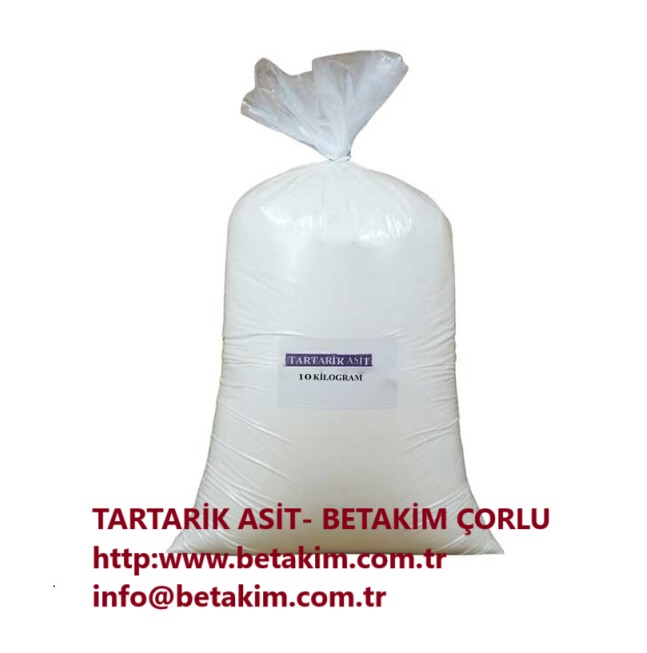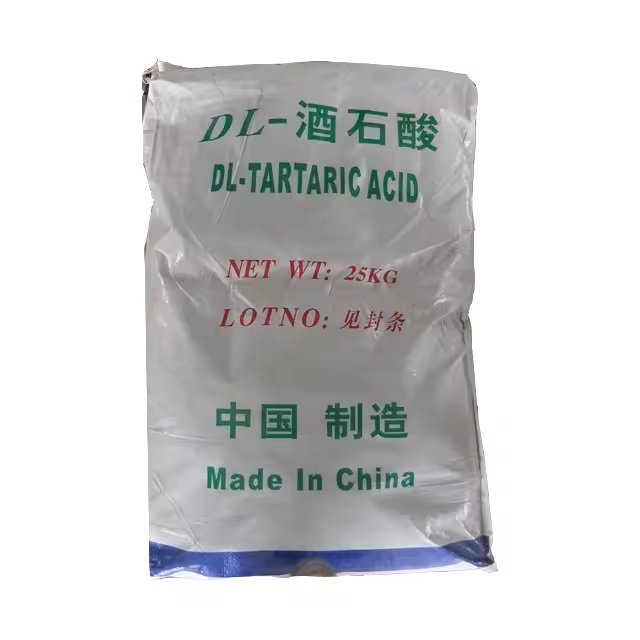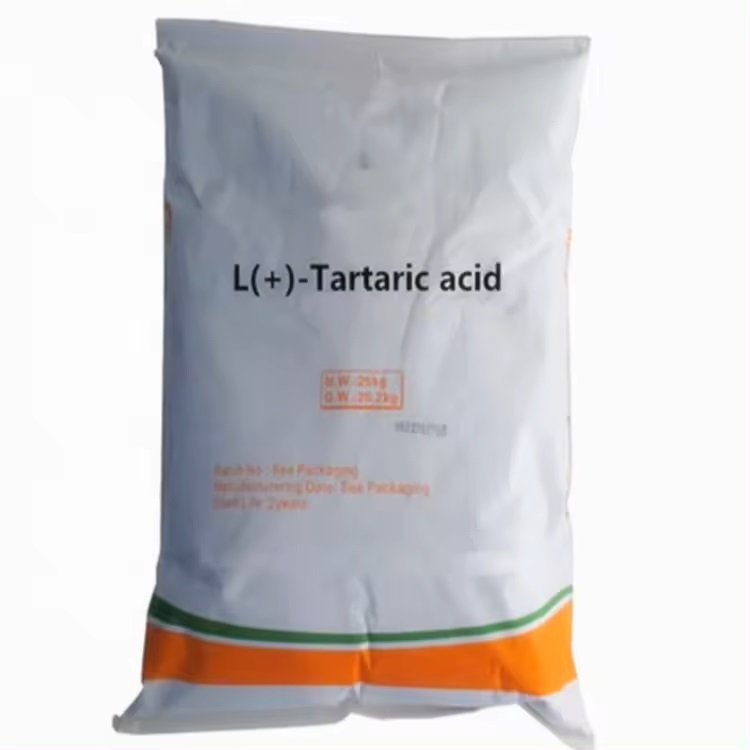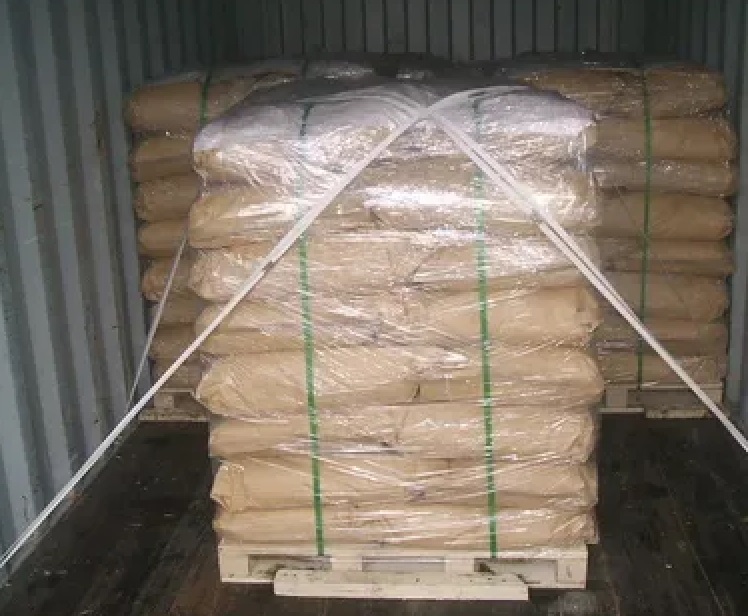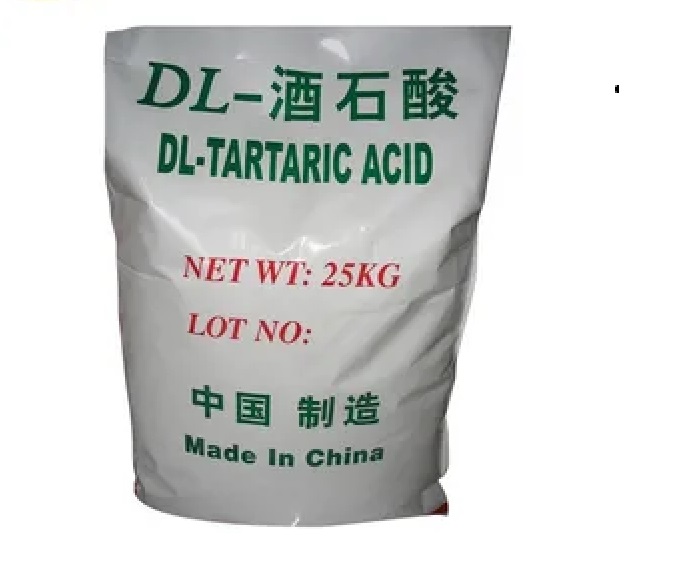We unleash your business potential by maximize the business innovation.
Send EmailE334, Tartaric Acid, Racemic Acid, Paratartaric Acid, Tartrate, Uvic Acid, DL-Tartrate, Dihydroxy Butanedioic Acid, 87-69-4
Tartaric Acid (E334)
Tartaric acid is a naturally occurring dicarboxylic acid found primarily in grapes and other fruits. It plays a key role as an acidulant in food and beverage industries and serves various pharmaceutical and industrial applications.
Physical & Chemical Properties
| Property | Value |
|---|---|
| Chemical Formula | C₄H₆O₆ |
| CAS Number | 87-69-4 |
| Molar Mass | 150.09 g/mol |
| Melting Point | 168–170°C |
| Solubility | Highly soluble in water |
Applications
-
Food Industry:
-
Used as an acidulant in soft drinks, candies, and baked goods.
-
Enhances flavor balance and acts as a preservative.
-
Important in wine production, contributing to stability and taste.
-
-
Pharmaceuticals:
-
Used in effervescent tablets for better solubility.
-
Applied in medicines to control pH balance.
-
-
Industrial Uses:
-
Helps in metal complexing and electroplating.
-
Used in textile dyeing processes.
-
Alternative Names
-
Racemic Acid
-
Paratartaric Acid
-
Tartrate
-
Uvic Acid
-
DL-Tartrate
-
2,3-Dihydroxybutanedioic Acid
CAS: 87-69-4
Molecular Formula: C4H6O6
Names and Identifiers
| Name | L(+)-Tartaric acid |
| Synonyms | FEMA 3044 L-Tartaric Acid L+tartaric acid L(+)tartaric acid ACIDUM TARTARICUM L(+)-Tartaric acid L(-)-tartaric acid L(+)-Tartaric Acid L-(+)-Tartaric acid DEXTROTARTARIC ACID Natural tartaric acid DIHYDROXYSUCCINIC ACID L-Tartaric acid anhydrous (2R,3R)-(+)-TARTARIC ACID (2S,3S)-(-)-Tartaric acid L(+)-Tartaric Acid (FCCIV) L(+)-Tartaric Acid (BP2000) L(+)-Dihydroxysuccinic acid L(+)tartaric acid sigmaultra 2,3-DIHYDROXYDUTANEDIOIC ACID 2,3-DIHYDROXYBUTANEDIOIC ACID 2,2-dihydroxybutanedioic acid (2R,3R)-2,3-dihydroxybutanedioate (2R,3S)-2,3-dihydroxybutanedioate (2R,3R)-2,3-DIHYDROXYSUCCINIC ACID L(+)-2,3-dihydrooxy butanedioic acid L-1,2-Dihydroxyethan-1,2-dicarbonsaeure |
| CAS | 87-69-4 |
| EINECS | 201-766-0 |
| InChI | InChI=1/C4H6O6/c5-1(3(7)8)2(6)4(9)10/h1-2,5-6H,(H,7,8)(H,9,10)/p-2/t1-,2+ |
| InChIKey | FEWJPZIEWOKRBE-JCYAYHJZSA-N |
Physico-chemical Properties
| Molecular Formula | C4H6O6 |
| Molar Mass | 150.09 |
| Density | 1.76 |
| Melting Point | 170-172°C(lit.) |
| Boling Point | 191.59°C (rough estimate) |
| Specific Rotation(α) | 12 º (c=20, H2O) |
| Flash Point | 210 °C |
| JECFA Number | 621 |
| Water Solubility | 1390 g/L (20 ºC) |
| Solubility | Soluble in water, methanol, propanol, glycerin and ethanol, insoluble in chloroform. |
| Vapor Presure | <5 Pa (20 °C) |
| Vapor Density | 5.18 (vs air) |
| Appearance | White crystal |
| Color | White or colorless |
| Merck | 14,9070 |
| BRN | 1725147 |
| pKa | 2.98, 4.34(at 25℃) |
| PH | 3.18(1 mM solution);2.55(10 mM solution);2.01(100 mM solution); |
| Storage Condition | Store at +5°C to +30°C. |
| Stability | Stable. Incompatible with oxidizing agents, bases, reducing agents. Combustible. |
| Sensitive | Easily absorbing moisture |
| Refractive Index | 12.5 ° (C=5, H2O) |
| MDL | MFCD00064207 |
| Physical and Chemical Properties | Density 1.76 melting point 168-172°C flash point 210°C Specific Rotation 12 ° (c = 20, H2O) water-soluble 1390g/L (20°C) |
| Use | L( )-tartaric acid is widely used as a acidulant for beverages and other foods, for wine, soft drinks, sweets, bread, and certain gum-like sweets. Mainly used as acidulants, resolving agents and pharmaceutical raw materials |
Risk and Safety
| Hazard Symbols | Xi - Irritant |
| Risk Codes | R36/37/38 - Irritating to eyes, respiratory system and skin. R41 - Risk of serious damage to eyes |
| Safety Description | S26 - In case of contact with eyes, rinse immediately with plenty of water and seek medical advice. S36 - Wear suitable protective clothing. S37/39 - Wear suitable gloves and eye/face protection S36/37/39 - Wear suitable protective clothing, gloves and eye/face protection. |
| WGK Germany | 3 |
| RTECS | WW7875000 |
| TSCA | Yes |
| HS Code | 29181200 |
| Hazard Note | Irritant |
Upstream Downstream Industry
| Raw Materials | Hydrogen peroxide |
Nature
colorless or white crystalline powder. Odorless and sour. Soluble in ethanol, methanol, ether, insoluble in chloroform.
Preparation Method
in the production of wine tartar as raw material, it is converted into calcium salt, and then a slight excess of dilute acid to its decomposition. Or maleic acid and hydrogen peroxide as raw materials, at a certain temperature into epoxy succinic acid, and then hydrolyzed to DL-tartaric acid. Can also be synthesized by chemical
The epoxysuccinic acid obtained by the method is L() tartaric acid by the action of the ring opening enzyme contained in Nocardia succinate.
Introduction
It can form soluble complexes with several element salts, which are widely used in qualitative and quantitative analysis, such as masking iron, aluminum, titanium, and tungsten ions during precipitation. Dissolve certain melts (such as niobium oxide, tantalum oxide and potassium pyrosulfate). Inspection or determination of potassium salt.
Use
biochemical research, masking agent, tanning industry, beer foaming agent. Test or determination of potassium salts. It can act with several elemental salts to form soluble complexes (such as niobium oxide, tantalum oxide and potassium pyrosulfate). Photo industry.
Content analysis
about 2g of a sample pre-dried on phosphorus pentoxide for 3H was accurately weighed and dissolved in 40ml of water, several drops of phenolphthalein test solution (TS-167) were added and titrated with 1 mol/L sodium hydroxide solution. Each Ml of 1mol/L sodium hydroxide solution is equivalent to 75.04mg of tartaric acid (C4H6O6).
Storage and Transportation
25kg plastic woven Kraft paper bags, packed with plastic film bags, stored in a clean, dry and ventilated warehouse.
Synthetic Methods
1. In the production of wine tartar as raw material, it is converted into calcium salt, and then a slight excess of dilute acid to decompose the obtained. Or maleic acid and hydrogen peroxide as raw materials, at a certain temperature into epoxy succinic acid, and then hydrolyzed to DL-tartaric acid. It is also possible to obtain L(-) tartaric acid by the action of a ring-opening enzyme contained in Nocardia succinate from epoxysuccinic acid obtained by a chemical synthesis method.
2. Distilled water was added to industrial tartaric acid and dissolved by steam heating and stirring. Add an appropriate amount of activated carbon, fully stir and then stand, filter, heat and concentrate the filtrate to the surface of the conjunctiva, while hot Suction filtration, filtrate cooling crystallization, after complete, the crystals were washed with a small amount of distilled water, and then dried at 30 to 40 ° C. With a non-stick spoon. If the activated carbon decolorizing temperature is controlled to 80 ℃, after filtration, it is concentrated under reduced pressure at 80 ℃, cooled and crystallized, and the obtained crystals are recrystallized in a non-iron container, refined and dried at low temperature, L-tartaric acid L-tartaric acid products are available.
Safety instructions
first aid measures
[food intake] do not give anything to eat, in the Coma state of the people. Do not induce vomiting. If awake and alert, rinse your mouth with milk or water to drink 2-4 cupfuls,. If irritation symptoms or symptoms occur, seek medical assistance.
[Inhalation] immediately from the scene to fresh air. If you are not breathing, perform artificial respiration. Such as Dyspnea, to the delivery of oxygen. Seek medical attention if Cough or other symptoms occur.
Skin: Rinse your skin with plenty of soap and water for at least 15 minutes to remove contaminated clothes and shoes. Seek medical assistance if stimulation is exacerbated or sustained. Clothing should be washed before re-use.
Eyes: Rinse the eyes with plenty of water for at least 15 minutes and lift the upper and lower eyelids from time to time. He received medical assistance.
treatment
[treatment] thoroughly clean after operation. Take off the contaminated clothes and clean them for reuse. Reduce dust generation and accumulation. Avoid contact with eyes, skin and clothing. Keep the container closed. Avoid ingestion and inhalation. Do not swallow or inhale. Use with adequate ventilation.
hazard identification
[ingestion] caused gastrointestinal irritation symptoms, Nausea, Vomit and Diarrhea.
Inhalation causes irritation of the respiratory tract.
Skin causes skin irritation. The risk to the usual industrial treatment is low.
Eyes cause eye irritation.
[EC phrase] R 36/37/38
EC safety phrase S 26 36
exposure control/personal protection
[personal protection] Eyes: Wear suitable protective glasses or chemical safety goggles, OSHA's eye and face protection regulations 29 CFR 1910.133 or European standard EN 166. Skin: wear appropriate protective gloves to prevent skin contact. Clothing: wear appropriate protective clothing to prevent skin contact.
The respiratory protection program for respirators is designed to meet OSHA 29 CFR 1910.134 and ANSI Z88.2 requirements or European Standard EN 149 when operating conditions must be observed to ensure the use of respirators.
Fire fighting measures.
[Flash point] 209
[Spontaneous combustion] 425
【 Fire extinguishing 】 self-contained respirator equipment, MSHA / NIOSH (or equivalent), and full-body protective clothing shall be worn under pressure. In the event of a fire, irritating and highly toxic gases may be produced by thermal decomposition or combustion. Fire extinguishing agent: use the most suitable fire extinguishing agent. In the case of spray with fire water, dry chemical powder, carbon dioxide, or appropriate foam.
accidental leakage treatment measures
[small leakage/leakage] to avoid the flow of runoff into the sewer and ditch channels. Clean the leak immediately and use appropriate protective equipment. The cleaned or absorbed material is then placed in a suitable clean, dry, closed container for handling. Avoid the production of dust-laden conditions. Provide good ventilation.
storage and transportation characteristics
[storage] storage in a closed container. Store in a cool, dry, well-ventilated place away from incompatible substances.
Introduction
L-tartaric acid is an organic compound. It is a dicarboxylic acid formed by the condensation of two hydroxyacetic acid molecules. L-tartaric acid is a colorless crystalline or crystalline powder that is soluble in water and alcohol solvents.
L-tartaric acid has certain applications in chemical experiments and other fields. In chemical experiments, it is commonly used as an indicator for complexometric titration, for quantitative analysis and quality control.
Toxicity and use limits
L-tartaric acid is a common organic acid. In chemistry, L-tartaric acid is an optical isomer and a colorless crystalline solid.
According to food safety standards, there will be regulations on the limit of use for L-tartaric acid. The usage limit refers to the maximum allowable concentration of L-tartaric acid added to food. The specific usage limit may vary depending on the regulations and standards of different countries and regions. Generally speaking, the food industry strictly adheres to hygiene standards and controls the amount of additives used to ensure food safety and compliance.
It should be noted that although L-tartaric acid has low toxicity, excessive intake may cause some problems such as abdominal pain, diarrhea, fatigue, etc. Therefore, when using L-tartaric acid, it is still necessary to follow the principle of moderate use and control intake to ensure food safety and health. If there are any doubts or worsening symptoms caused by the intake of L-tartaric acid, it is recommended to seek medical attention promptly.
Reference Information
| FEMA | 3044 | TARTARIC ACID (D-, L-, DL-, MESO-) |
| Introduction | tartaric acid, 2, 3-dihydroxysuccinic acid. Molecular formula: HOOCCHOHCHOHCOOH, or dihydroxysuccinic acid. There are two asymmetric carbon atoms, there are three stereoisomers, namely: dextrorotatory (D-type, L-type), levorotatory (L-type, D-type), meso-type. Typically, the racemic form of tartaric acid is also referred to as grape acid. D-type tartaric acid is widely distributed in higher plants in the form of free or K salt, Ca salt and Mg salt, especially in fruits and leaves. In the manufacture of wine, a large amount of tartar (potassium hydrogen salt) is deposited. In addition, its presence is also common in molds and lichens. Recently isolated tartaric acid fermenting bacteria (Gluconoba-cter suboxydans variant strain), in vivo is passed through glucose |
| Use | as an antioxidant added to foods, it can make foods have a sour taste. The greatest use of tartaric acid is as a beverage additive. It is also a raw material for the pharmaceutical industry. In the mirror industry, tartaric acid is an important additive and reducing agent, which can control the formation rate of silver mirror and obtain a very uniform coating. It is used as Biochemical reagent, masking agent and beer foaming agent, and also used in tanning industry. L( )-tartaric acid is widely used as a acidulant for beverages and other foods, for wine, soft drinks, sweets, bread, and certain gum-like sweets. Mainly as a sour agent, resolving agent and pharmaceutical raw materials. L( )-tartaric acid is widely used as a acidulant in beverages and other foods, for wine, soft drinks, candy, bread, and certain gum-like sweets. Using its optical activity, as a chemical resolution agent, for the preparation of anti-tuberculosis drug intermediate DL-amino butanol resolution; Can also be used as chiral raw materials for the synthesis of tartaric acid derivatives, as a polyester fabric Resin finishing catalyst, oryzanol production of PH regulator; The use of its complexation, used for electroplating, desulfurization, pickling and chemical analysis, pharmaceutical testing in the complexing agent, masking agent, chelating agent, printing and dyeing agent; The use of its reducing, used as a reducing agent for chemical mirror. A developer for photography. Can also complex with a variety of metal ions, can be used as metal surface cleaning agent and polishing agent. as an antioxidant added to food, it can make food have a sour taste. The greatest use of tartaric acid is as a beverage additive. It is also a raw material for the pharmaceutical industry. Tartaric acid is an important auxiliary agent and reducing agent in the mirror industry, which can control the formation rate of silver mirror and obtain very uniform coating pharmaceutical intermediate, resolving agent and metal ion masking agent; anti-dyeing agent; Chiral block for natural products, also with the compound TiCl2(O-i-Pr)2 to form Diels-Alder catalyst used as biochemical reagents, masking agent and beer foaming agent, also used in tanning industry L( )-tartaric acid is widely used as a acidulant for beverages and other foods, for wine, soft drinks, candy, bread, some gum-like sweets. Mainly used as acidulants, resolving agents and pharmaceutical raw materials |
| Application | tartaric acid is also an antioxidant and has applications in the food industry. It can be used as an oxygen scavenger in biochemical tests. Also known as 2,3-dihydroxybutanedioic acid. Structural simplicity HOOCCH(OH)CH(OH)COOH. Potassium hydrogen tartrate exists in grape juice, this salt is difficult to dissolve in water and ethanol, precipitation in the grape juice wine making process, called Tartar, the name of tartaric acid. Tartaric acid exists mainly in the form of potassium salt in a variety of plants and fruits, but also a small amount in the free form. Tartaric acid molecule contains two identical chiral carbon atoms (see asymmetric atoms), there are three stereoisomers: dextrotartaric acid, levorottartaric acid and meso-tartaric acid (see optical isomerism), the structural formula is: equal amount of mixture of dextrotartaric acid and L-tartaric acid |
| content analysis | accurately weigh about 2g of a sample pre-dried on phosphorus pentoxide for 3H, dissolve in 40ml of water, phenolphthalein test solution (TS-167) was added several drops and titrated with 1 mol/L sodium hydroxide solution. Each Ml of 1mol/L sodium hydroxide solution is equivalent to 75.04mg of tartaric acid (C4H6O6). |
| toxicity | LD504.36g/kg (mouse, oral). ADI 0-30mg/kg (sum of L-tartaric acid and its salts; FAO/WHO,1999). GRAS(FDA,§ 184.1099,2000). |
| Use limit | GB 2760-96: all kinds of food, GMP. FDA,§ 184.1099(2000):GMP. FEMA(mg/kg): Soft drink 960; Cold drink 570; Candy 5400; Baked goods 1300; Pudding 60; Gum 3700; Condiment 10000. |
| production method | 1. In the production of wine when the production of tartar as raw material, it is converted into calcium salt, and then a slight excess of dilute acid to its decomposition. Or maleic acid and hydrogen peroxide as raw materials, at a certain temperature into epoxy succinic acid, and then hydrolyzed to DL-tartaric acid. Can also be prepared by chemical synthesis of epoxy succinic acid, by Nocardia succinate contained in the role of the ring-opening enzyme and L() tartaric acid. 2. Distilled water was added to industrial tartaric acid and dissolved by steam heating and stirring. Add an appropriate amount of activated carbon, fully stir and then stand, filter, heat and concentrate the filtrate to the surface of the conjunctiva, while hot Suction filtration, filtrate cooling crystallization, after complete, the crystals were washed with a small amount of distilled water, and then dried at 30 to 40 ° C. With a non-stick spoon. If the activated carbon decolorizing temperature is controlled to 80 ℃, after filtration, it is concentrated under reduced pressure at 80 ℃, cooled and crystallized, and the obtained crystals are recrystallized in a non-iron container, refined and dried at low temperature, D-tartaric acid [L(+) tartaric acid] product can be obtained. |
| autoignition temperature | 797 ° F. |
L+ NATURAL TARTARIC ACID
Tartaric acid is a natural product of plant origin and is highly concentrated in fruits such as grapes and tamarind. Distillerie Bonollo Spa extracts from wine-making byproducts exclusively L+ Natural Tartaric Acid, which is not to be mistaken for the synthetic one of fossil origin. The considerable volumes of wine products processed ensure a constant supply of plant raw materials. The double crystallization guarantees the highest purity degree. The uses spread from bakery, confectionery, enology to pharmacology and the building industry.
USAGE:
BAKERY
The esters of tartaric acid, in combination with natural food-grade fatty acids, act as food emulsifiers improving gluten and providing excellent stability and longer shelf-life to bakery products.
CONFECTIONERY AND PRESERVES INDUSTRY
Tartaric acid intensifies any natural taste and, thanks to PH reduction, it hinders the growth and proliferation of molds and microorganisms.
WINE MAKING
In countries of noble viticultural tradition it is first choice in wine making.
PHARMACEUTICAL INDUSTRY
It is used in sparkling tablets formulation to favor a quick dissolution of the active ingredients.
GYPSUM INDUSTRY
When added to gypsum for wall plastering it gives higher workability and delayed hardening.
